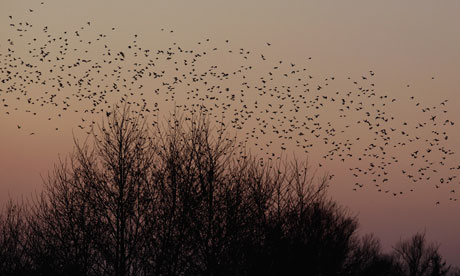The number of starlings seen in people's gardens has fallen by almost four-fifths since 1979, the RSPB has said.
The starling, famous for its winter displays known as murmurations involving up to hundreds of thousands of birds, has seen a steady decline in numbers since the RSPB's Big Garden Birdwatch survey began in 1979.
This year's survey of garden birds by members of the public revealed an average of just over three starlings per garden, compared to 15 in 1979, a fall of 79%, the wildlife charity said.
The RSPB also warned that the numbers seen in the murmurations, when the birds gather above roost sites at dusk and fly in patterns before settling down for the night, are also dropping.
It is not clear what is causing the declines, although possible causes include changes in their feeding habits and reductions in their insect food in the soil.
What is clear is that their decline in numbers is mirrored across much of northern Europe, making the bird red-listed as a major cause for concern.
RSPB scientist Mark Eaton said: "The unmistakable flash of the glossy purple green starling is a familiar sight for many, but sadly it seems their numbers have dropped even further in this year's survey.
"Despite usually being such a familiar and still widespread bird, their numbers have steadily dropped most years since 1979.
"We've been monitoring this decline and encouraging people to step up and help birds like starlings, but we will also be conducting some scientific research into the exact reasons for these declines.
"It would be a tragedy if the numbers continue to plummet and we will do all we can to help stop this happening."
The annual Big Garden Birdwatch survey, which involved 600,000 people this year, also revealed that there were fewer blackbirds and long-tailed tits in gardens this January than last year, down 22% and 33% respectively.
But the RSPB suggested the reduction could be down to the milder winter weather, which enabled the birds to find food out in the wider countryside.
The lack of a prolonged cold spell this year is likely to have benefited all birds, with more surviving and making a better start to the breeding season.
And there were some increases in the number of birds seen, with goldfinch numbers continuing to rise, and putting them in seventh place above robins in the top 10 most commonly spotted species.
Blue tit numbers were down slightly on last year's survey but are a fifth higher than when the project first started in 1979, the RSPB said.



